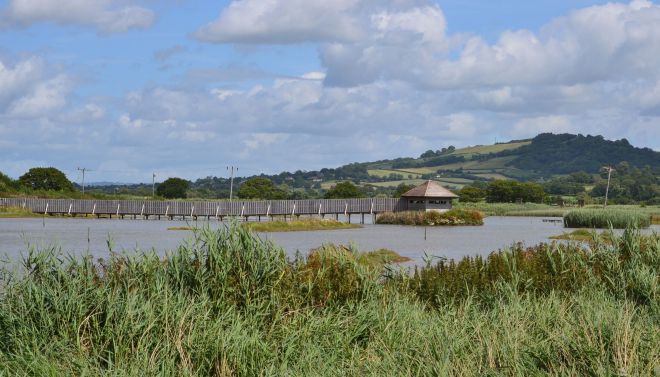“Accidental small sandpipers” to quote one field guide I use* is a genus that I attach some priority to at this stage of my birding life. Since various of these species occur almost annually in Great Britain, most seasoned birders may have seen each of them perhaps a few times. But given my modest British bird list of now 321 mostly within 150 miles of home, each passage period I aspire to gain one or two more of this group as lifers. Today was such an occasion.
Last week a Baird’s Sandpiper turned up at the populist playground of Minsmere in Suffolk but didn’t stay long enough for me to get there. Western Sandpiper has also been reported a bit further afield recently. Then two days ago a Least Sandpiper was found at Seaton Marshes in east Devon, that at a little over 150 miles was just within my preferred twitching range. I assume the last-named is the rarest of the three species since RBA accords it mega status. When this bird was reported again early Thursday morning on a work-free day, off I set.
For the outward journey I took the scenic route via Ringwood, Dorchester and Bridport to indulge my liking for the Dorset countryside. But as so often the beauty of that county’s scenery was spoiled by the volume of traffic on roads that are not designed to carry it. As a result almost an hour was added to my satnav’s estimated journey time, till at just before 1pm I drew up in a large and welcoming car park at Colyton cemetery (SY251916). From there a path leads down to Black Hole Marsh, one of four areas managed as local nature reserves in the lower Axe valley. Collectively these are known as Seaton Marshes.

Black Hole Marsh and Island Hide
The bird was being observed from the Island Hide (pictured above). Not having recovered from the journey I asked other people to point it out as soon as I went inside, but at that range it could have been anything. At first a big lens photographer in a prime spot and the head next to him kept blocking my every attempt at picking off the diagnostics. But eventually those obstructions parted in opposite directions and I gained a full frontal view of the Least Sandpiper looking just like the pictures in it’s RBA gallery (see here).
I stayed in the Island Hide for the next hour during which this bird remained faithful to the water’s edge near the start of the boardwalk that leads out to the hide. For much of the time the rare visitor, a summer plumaged adult was associating with a Dunlin by which it was quite dwarfed, while Common and Wood Sandpiper were also in the vicinity. I believe this site has a reputation for attracting good passage waders. But the comparison species I would really liked to have seen here would have been Little Stint.
As its name suggests Least Sandpiper is the smallest of the stint species. It has a squat body, rather short greenish legs and long toes. The dark bill is down-curved, tapering to a fine point. To quote the Helm guide to confusion species the key diagnostics that separate this bird from Little Stint are the leg colour and a very short primary projection. This was mostly fairly plain to decipher during my time in the hide, as other birders came and went and I got into the best viewing position. But to my mind the stand-out feature was the subtly attractive breast pattern that had stood out in the RBA photographs, as it did now in my scope.
All the while I hoped the Least Sand would relocate closer so that I might capture some half decent images. Eventually it was flushed by other birds and landed on a grassy area beside the board walk. Most people inside then moved out to attempt to photograph the rarity through slats in the wooden screen structure. At this point I was joined by Oxonbirder Dave Lowe who was “on the way” (as we say locally) home from a business meeting in Tiverton. He pointed out the Least Sand again quite close to the screen and I happened to be in a good spot to get two lucky shots (above) as the bird crossed the grass back to the water’s edge. It being some time since I have returned from a British birding twitch with publishable pictures, I’m quite pleased with those two. What a little beauty!
Mission accomplished, Dave and myself both left after 3pm to make our way homeward. Not wanting to brave the Dorset lanes again then Poole’s outskirts in the rush hour, I chose the fast M5 / M4 motorway route which in the event was largely congestion free. With the warm glow of having acquired such a rare and attractive lifer, and the bonus of reasonable pictures, all was well in my world at least for one more day.
* Six (that is 50%) of the group I refer to here are now on my British list. The others are Semipalmated Sandpiper, White-rumped Sandpiper, Long-billed Dowitcher, Short-billed Dowitcher and Pectoral Sandpiper. Still to be added are Long-toed Stint, Western Sandpiper, Red-necked Stint, Baird’s Sandpiper, Stilt Sandpiper and Sharp-tailed Sandpiper. If the taxonomy here is inaccurate, the pocket field guide referred to at the beginning of this post is Bruun, Delin and Svensson’s excellent Hamlyn Guide that I keep in the car as a small, light alternative to Collins. This publication is also very dear to me having been carried in the field throughout my early birding years. The borrowed term “accidental small sandpipers” is merely a convenient way of denoting the above group of scarce or rare passage waders.


